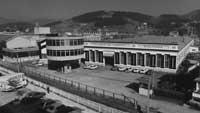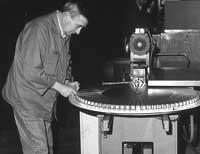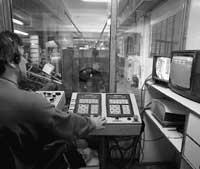Small businesses and employment in the Basque Country
1996/10/01 Aranguren, Mari Jose Iturria: Elhuyar aldizkaria

The factors that can influence the generation of unemployment can be many and varied, so it is difficult to analyze them properly. In any case, the analysis of the creation and the loss of employment can make evident this turbid problem, which is what we will try to do in this small work, but because of the risk that the limits of length remain on the surface, we will limit ourselves to analyzing a sector of great weight and tradition in the Basque economy, that is, the manufacturing industry. Given the high impact it has on other sectors, this case seems very significant to us.
Therefore, this study will analyze the evolution of employment in the manufacturing industry of the ACBC between 1984 and 1993, as well as the incidence of establishments of different sizes in this evolution.
Throughout the 1984-1993 decade, the number of jobs in the Basque manufacturing industry has decreased by 25%(1), but this loss has not occurred in establishments of all sizes: The loss of employment has only occurred in companies with more than 19 employees, while in those with more than 20 employees jobs have been generated. Consequently, while in 1984 small establishments accounted for 35% of employment in the manufacturing industry, in 1993 this value reached 50%(2); the weight of large establishments in the manufacturing industry has gone from representing 32% in 1984 to representing 17% (3) in 1993 (see table 1).
198,1993 1-9 10-19 20-49 50-99 100-499 49915005% 6.2 15701% 27019% 11,1 28070% 11,6 80050% 33,0 76494% 31,634824% 17,6 21014% 10,6 24780% 12,5 26724% 13,5% 59037% 29,8% 314919010.5% Eustat and its own elaboration.As can be seen in this table, during the years 1984 to 1993 things have changed considerably in the Basque manufacturing industry, since the weight of small establishments in the evolution of employment has increased considerably, which allows to affirm that large establishments have an increasing weight.

And, of course, the following question immediately comes to mind: What has happened in the last ten years for small establishments to rise so much and lower the largest? There are many factors at stake, but in our opinion the importance of:
- Small establishments that open generate more employment than large ones and, at the same time, large establishments that close generate greater job losses. Anyone can understand the teaching of this situation: more small establishments must be opened rather than large ones. The impact on the employment of opening and closing establishments is due to the influence of new entrances and exits.
- Establishments that, as a result of the loss of employment of large establishments, move to the lower sections – and their corresponding employment – are superior to establishments that, as a result of the jobs won in small establishments, pass to the upper sections, and to which they have the corresponding employment. We will call transfer entries and exits to changes of employment by establishments that pass to the upper and lower sections.
- Small and still small establishments generate more employment than large ones and those that remain large or lose less employment. These will be called a change in the employment of establishments that remain in the same rank.

The Basque manufacturing industry had 25% fewer jobs in 1993 due to new entrances and exits for transfers, as well as the loss of employment in unalterable establishments. This means, on the one hand, that establishments that have remained in the same period of time have lost employment, on the other, that the establishments that have closed have lost more employment than the ones that have created newly opened establishments and, finally, that the number of medium and small establishments has increased due to the loss of jobs of the large establishments and the passage to the lower sections.
Although these three factors have been in common, the impact of the three has not been the same in the Basque manufacturing industry; according to the data obtained, the loss of employment of establishments maintained in the same period has been decisive in the jobs that our industry has lost. It should be noted, moreover, that the loss in establishments that remain in the same period has occurred in companies of all sizes, that is, establishments that have not varied in size and therefore have not varied of space have lost jobs in the CAPV during the years 1984-1993
The negative impact of the entrances and exits for transfers has occurred mainly in very small establishments (from 1 to 9 employees) and large ones (from more than 500 employees), while in the rest it can be said that they have had a positive effect. This does not especially affect very small establishments, but in large ones it is of vital importance. In some ways, the slight increase in size and the move to a greater range of establishments with less than 10 employees has meant only a loss of 219 workers, while establishments of 500 or more employees have lost 19,165 jobs by transfers (see table 2).
1984-93 Change of total employment
1984-93 New entrances and exits 1984-93 Transfer. 15,1-13- Changes of employment 1984-93.-1-9 10-19 20-49 50-99 100-499 4994809 4168 - 2653 - 1346 - 21013 - 45041% 179.18% 32.34% - 62.91% 230,53% - 36.63% - 9.95% - 4.55% - 6.74% 290.96% Phenomena that have influenced the change of importance in the Basque manufacturing industry. Source: Eustat and its own elaboration.Finally, it is worth noting the number of jobs generated by new entrances and exits in establishments of less than 20 employees and the loss of jobs in establishments of more than 20 employees (see table 2). That is, establishments of less than 20 employees that have opened in the Basque manufacturing industry have created more jobs than those that have lost those that have closed. On the contrary, the impact of establishments of more than 20 employees in the Basque industry has been much blacker than that of opening lost jobs.

When analyzing the conclusions of this study, we can say that small businesses can play an important social role, as is the case of the CAPV, although in many studies of Industrial Economy it is said that the high relative weight of small companies in the industry of the country hinders the competitiveness of the country. We have data showing it: From 1984 to 1993, 61,076 jobs have been lost in the manufacturing industry, but in establishments of less than 20 employees, 9,965 jobs have been created for new entrances and exits.
The three phenomena mentioned and analyzed in the last decade have meant a generalized decrease in the size of establishments in the Basque manufacturing industry. In 1984 the average staff per establishment was 38 people, while in 1993 the average staff was less than half, 16 workers.
These are, as readers, objective data. The importance of small establishments in the ACBC is clearly high, so when structuring the Industrial Policy, it is possible to consider them. Measures aimed at improving the competitiveness of small establishments will contribute to improving the economy as a whole.
1984199319931-9 10-19 20-49 50-99 100-499 4994 14 31 7 203 11953 4 31 70 198 10852 14 31 70 198 1085Total 381416 Table 3 Evolution of employment in Basque manufacturing establishments 1984-1993 Source: Eustat and its own elaboration.These data have been extracted from the Eustat directory, with the last available data corresponding to 1993. Please note that Eustat has significantly improved its directory since 1990, especially for establishments with less than 10 employees. Thanks to this innovation in the directory there are 3,253 more establishments in the Eustat directory, of which 3,162 are less than 10 employees, 79 between 10 and 19 employees and 12 between 20 and 49 employees. As a consequence of the improvement of the directory one can think that there has been an increase in employment; it is not known exactly what has been that apparent increase, but knowing the size of the establishments that have been included in the directory can make a certain approximation. Thus, it is estimated that there has been an increase in employment as follows: in establishments with less than 10 employees, around 15,810 people, 10 to 19 workers, about 1,145 people and 20 to 49 workers, about 414 workers. However, we will not take into account the novelty of the Eustat directory, since the incorporation of employment to existing companies but not included in the directory can totally distort the situation. |

Gai honi buruzko eduki gehiago
Elhuyarrek garatutako teknologia






